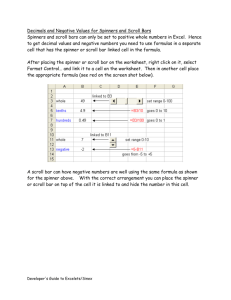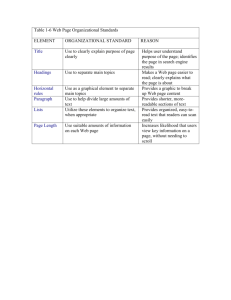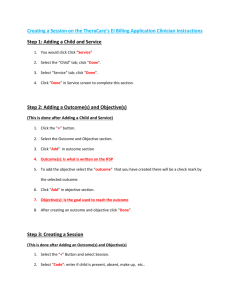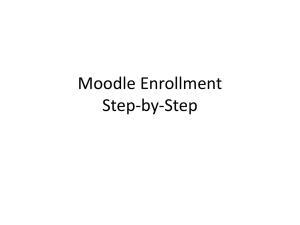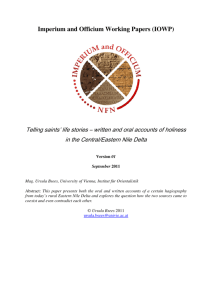Oral or written transmission, oral or written reception? – The case of
advertisement
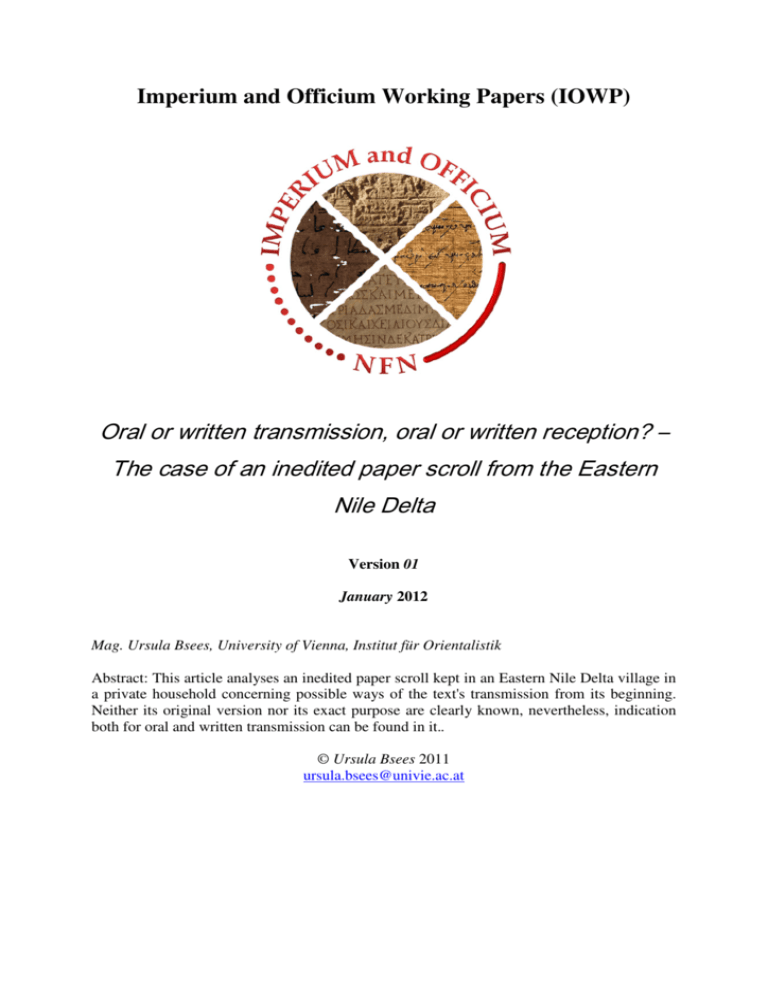
Imperium and Officium Working Papers (IOWP) Oral or written transmission, oral or written reception? – The case of an inedited paper scroll from the Eastern Nile Delta Version 01 January 2012 Mag. Ursula Bsees, University of Vienna, Institut für Orientalistik Abstract: This article analyses an inedited paper scroll kept in an Eastern Nile Delta village in a private household concerning possible ways of the text's transmission from its beginning. Neither its original version nor its exact purpose are clearly known, nevertheless, indication both for oral and written transmission can be found in it.. © Ursula Bsees 2011 ursula.bsees@univie.ac.at Oral or written transmission, oral or written reception? – The case of an inedited paper scroll from the Eastern Nile Delta 2 One of the questions coming up in the course of our work on an inedited paper scroll from Ṣafṭ Zurayq in the Eastern Nile Delta is the way of transmission used to spread the text originally. One has to assume that the text we are working on is a later copy of the original and it can not be said how often the text was copied, but it is clear that it was copied once at the very least. Here, I will focus on whether the original text was transmitted orally and written down from dictation or whether the first draft had already been composed from other text sources. Oral transmission of contents such as nasab and poetry played a very important role in pre-Islamic culture; knowledge in writing was not widely spread. With the emergence of Islam and the necessary recording of administrative practices such as tax gathering came the need for literacy, which, however, did not necessarily touch all spheres of life. For example, the word qurʾān could be perceived not as “something to read”, following today’s basic interpretation of the root q-r-ʾ, but much more as “something to be recited.” “The basic meaning of qurʾān, after all, is “recitation.”1 The root q-r-ʾ therefore should not only be perceived as describing a more or less internal and silent process of reading, but as an expression used for recitation in front of an audience. “For modern literates, reading is a silent, wholly mental process, but until quite recently reading in all cultures was a vocal and physical activity. Reading aloud also gave nonliterates access to writing, and most literates preferred listening to a statement rather than perusing it in script.”2 Documentary evidence from early papyri underlines the oral aspect even of administrative letters. Moreover, the traditional way of receiving the knowledge about a certain text was usually not reading it by oneself but hearing it from a teacher at a session called samāʿ and copying it down from his words. Texts composed in this way were guaranteed their correctness by reading them to the teacher again. If he found it to 1 Donner Fred M., Narratives of Islamic Origins. The beginnings of Islamic Historical Writing. (Studies in Late Antiquity and Early Islam 14). Darwin Press, Princeton – New Jersey 1988. p.62 2 Bloom Jonathan M., Paper before print - The history and impact of paper in the Islamic world. Yale University Press, New Haven – London 2001. p.95 NFN Imperium and Officium. Comparative Studies in Ancient Bureaucracy and Officialdom Oral or written transmission, oral or written reception? – The case of an inedited paper scroll from the Eastern Nile Delta 3 be correct in every aspect, he permitted the scribe to pass on the text. This authorisation is called iǧāza. There are two hints to iǧāza in the manuscript we are working on. In line eleven, we find that the nasab from Muḥammad to ʿAdnān received iǧāza from Imām aš-Šāfiʿī and Imām Mālik. An even clearer description of the process of acknowledgement begins in line 354, where we can read “After the mentioned story and chain of ancestors had been read by the poor ʿAbd ar-Raḥmān, son of the poor in God, the Exalted, Ismāʿīl, son of the deceased, the poor in God, the Exalted, Ḥasan […] son of our master and patron in God, the Exalted, Ṭarḫān b. Kāmil b. Sayf b. ʿUqba b. ʿAlawī b. Sharafī b. Qays b. Saʿd b. ʿUbāda, at the shrine of his ancestor Qays b. Saʿd in Alep […], he also ascertained his chain of ancestors and his cousins’ chain of ancestors, […].”(l.354-359) In the scroll, we find evidence for both oral and written transmission. One of the hints to a possible oral aspect is the existence of poetry in the text. One can hardly imagine that this kind of text was ever meant to be read by someone silently to themselves. The matter of rhythm and rhyme make poetry the category most in demand of oral recitation. This is emphasized by the kind of poem presented here: it is a hijāʾ by Ḥassān b. Ṯābit, an answer to an oral attack in the shape of an invective meant to humiliate the aggressor in public. Another sign for oral transmission could be a very short Coranic passage in the text. Not only was Coran generally recited, not read silently, but this special passage from Sūrat al-Ḥashr (59), verse 2, ﻓﺎﻋﺘﱪﻭﺍ ﻳﺄﻭﱄ ﺍﻷﺑﺼﺎﺭ,3 is completed by another verse, ﻟﻌﻠﻜﻢ ﺗﺮﲪﻮﻥ, which does not follow it in this sūra but appears on several other occasions in the Coranic text. Copying Coranic verses in another sequence than that of the Holy Book would be regarded as a breach of sacrilege. However, when writing down from a lecture (or a recital?), one does not have a Coran exemplar at hand to look the recited verses up. Even if the scribe knew the verses by heart and therefore noticed the incoherence between the lecture and the Coranic text, he certainly saw himself in no position to question a scholar’s words. 3 In the scroll: ﻳﺎ ﺃﻭﱃ. NFN Imperium and Officium. Comparative Studies in Ancient Bureaucracy and Officialdom Oral or written transmission, oral or written reception? – The case of an inedited paper scroll from the Eastern Nile Delta 4 Some conspicuous signs of Middle Arabic, also called Vernacular Arabic, appear in the scroll’s text. If they do not allude to an oral transmission of the text, they show at least a very strong influence of spoken Arabic on the text’s diction. We can clearly see this at examples like Ḥārisa for the common Ḥāriṯa (line 41) or ṭār for ṯaʾr (line 65). With Ṣafṭ Zurayj (sic) in the small text added after the end of the main text, we come across another example of Middle Arabic which needs to be explained: The word Zurayq in Classical Arabic is realised Zrēg or Zrīg in the region’s dialect, qāf becomes g. Now we must bear in mind that many dialects have g for jīm (which stays jīm in the local dialect). Obviously, the scribe heard g and, according to his own dialect, thought of jīm, not qāf. Two times in the scroll’s text, the narrator changes the grammatical person from the third to the first person, one time without an obvious reason (line 195), “so the ʿurbān travelled on and encamped at Badr with Ṣaġm b. al-ʾAswad al-Hanatī and we could not even bear it one day” and another time in a passage with a small part echoing direct speech, after which the person is not changed back to the narrative’s general third person for eight lines. It then continues normally, in the third person. Both the first and the second example hint at a composition of the text after a lecture or after dictation, in which the scholar or learned man identified with one of the story’s protagonists as he was emotionally touched by the text. Although the oral aspect of the text seems to be quite strong, we must nevertheless bear in mind that also contrary evidence could be gathered. When regarding the nasab from Muḥammad to Adam, on which there is no final consensus among Islamic scholars (l.7-18), we notice some similarity to the one listed in Ibn Hishām’s Sīra nabawīya.4 The differences between the two chains concern, to a small extent, deviating names or a different order of names. Let us emphasise that there are two names in which diacritics obviously differ due to errors in copying. Where Ibn Hishām has ﺬﺨﺸ ﺭﹶﻓ ﺃ, the scroll has ﺍﺭﻓﺨﺸﻨﺪ, likewise we find ﺷﻠﹶﺦ ﻮﻣﺘ and in the scroll ﻣﺘﻮﺷﺎﻉ. It is only too easy to imagine a scribe copying from a maybe partially illegible or destroyed (or both) original, the condition of which we can only guess, misreading a connected lām for an alif and a ḏāl for a nūn-dāl sequence 4 as-Saqqāʾ Muṣṭafā (ed.), Ibn Hishām, as-Sīra an-nabawīya. vol.1, l.2 NFN Imperium and Officium. Comparative Studies in Ancient Bureaucracy and Officialdom Oral or written transmission, oral or written reception? – The case of an inedited paper scroll from the Eastern Nile Delta 5 Apart from these orthographical clues, we find that the bayʿa for Muḥammad which the anṣār undertake on line 68-69, is, apart from negligible details, identical with the formula recorded by al-Balādhurī in Ansāb al-ʾashrāf.5 Since the bayʿa had no established formula which had to be said on those occasions, we could assume that Balādhurī’s text has in some way influenced our scroll. The same can also be said about Ṣaḥīh al-Bukhārī and Ṣaḥīḥ Muslim, although with these two works of hadīth, one has to be more careful: Meaningful parts of them have been used in so many works from other Islamic scientific disciplines that an appearance of an – originally – Bukhārī or Muslim passage does not automatically lead to the Ṣaḥīḥ itself, but maybe to another text in which some aḥādīth were incorporated. The several parts which – maybe – have been taken from al-Bukhārī and Muslim appear in the scroll as one quotation of the Prophet Muḥammad, in which he underlines the anṣār’s extraordinary piety and their outstanding qualities of loyalty and noble descent (l.78-83). Another passage most probably taken from a classical work of – presumably – history is, although short, even more remarkable because we only found it in two works of Classical Arabic history, i.e. Futūḥ al-Shām by al-Wāqidī (?) and ʿIqd al-jumān by alʿAynī.6 The scroll has “They took revenge (ṯaʾr) for it and covered the blemish until blood kept running from their arms like camels’ entrails” (l.122-123) and then again “and the anṣār fought until every knight from ʿUbāda’s sons had blood running from his arms like camels’ entrails” (l.142-143), whereas al-Wāqidī and al-ʿAynī have ﻓﻨﻈﺮ ﺍﻟﻴﻪ ﻭﺍﻟﺪﻡ ﻋﻠﻰ ﺃﻛﻤﺎﻡ ﺩﺭﻋﻪ ﻛﺄﻛﺒﺎﺩ ﺍﻹﺑﻞand ﺎ ﺣﱴ ﺻﺎﺭ ﺍﻟﺪﻡ ﰲ ﺍﻷﺯﻗﺔ ﻛﺄﻛﺒﺎﺩ ﺍﻹﺑﻞﻭﺩﺍﻡ ﺍﻟﻘﺘﻞ ﻭﺍﻟﻨﻬﺐ ﰲ ﺑﻐﺪﺍﺩ ﺃﺭﺑﻌﲔ ﻳﻮﻣ. The context is quite different but, as far as we could check, these are the only classical sources featuring this specific use for camels’ entrails which tells us that the scribe of the text’s first version must have had access at least to one of them. 5 al-Balādhurī, Ansāb al-ʾashrāf. p.165 6al-Wāqidī Abū ʿAbd Allāh b. ʿUmar, Futūḥ al-Shām p.136 and al-ʿAynī Badr ad-Dīn, ʿIqd al-Jumān fī tārīkh ahl az-zamān p.68 NFN Imperium and Officium. Comparative Studies in Ancient Bureaucracy and Officialdom Oral or written transmission, oral or written reception? – The case of an inedited paper scroll from the Eastern Nile Delta 6 An indication for the written composition and especially the written transmission of the text could be found in the various passages crossed through and, in most cases, repeated in the appropriate place (l.231, 316, 327, 349). The fact that there is a footnote without text – only a small Indian three appears – and that the illegible or false word seems to have been copied meticulously points if not at a written transmission from the beginning, than at least at a strong (and long) tradition of written transmission. The same can be said about the fact that the colophon, originally the most individual part of a manuscript, has also been copied, which we deduce from the year 647 AH mentioned in the text, a date that just does not comply with the type(s) of script used in the scroll. The existence of poetry in the text, which we took as an indicator for the text’s “oral life,” could, as we must concede, also allude to written transmission, although we can not tell in which stage of the text’s “life,” which we (I) estimate to be about 400 years. The poem by Ḥassān b. Ṯābit appearing in the text has been transmitted in different numbers of verses, but there is an account of it which looks very much like what is written in our manuscript and that is in Ibn ʿAsākir’s Tārīkh madīnat dimashq. The number of verses and even their order are identical (except for one verse)7. To declare all these similarities of our manuscript with other texts pure coincidence would be a denial of the permeation of a wide range not of geographical regions, but also of social strata by certain texts but still, we can not decide which way of transmission predominated in the manuscript we are working on. As we already mentioned above, the text was read to an authority in order to have its correctness checked. This tells us that, at least until the passage reporting the reading, the text must be considered an entity in its own. Only after that can we start an analysis encompassing all text parts. We think that the part until the ijāza which took place in Alep had a long oral tradition before being established in writing. It is possible that the parts taken from other works by authors such as al-Balādhurī, Ibn ʿAsākir, al-Wāqidī or al-ʿAynī and maybe alBukhārī and Muslim were only added in the process of writing it down, since they 7Badrān Abd al-Qādir (ed.), Tahḏīb tārīḫ dimašq li-bni ʿAsākir. aṭ-Ṭabʿa aṯ-ṯāliṯa. Dār ʾiḥyāʾ at-turāṯ al- ʿarabī, Bayrūt. vol.4, p.130f. NFN Imperium and Officium. Comparative Studies in Ancient Bureaucracy and Officialdom Oral or written transmission, oral or written reception? – The case of an inedited paper scroll from the Eastern Nile Delta 7 added credibility to a text now more palpable than the earlier oral tradition. This consolidation of something concrete certainly contributed to the importance and spiritual character of the text, because it now existed “in writing,” thus giving it more authority than a tale told by grandfathers or transmitted from a Sufi-shaykh to his pupils. It became an authoritative source for local history and genealogy, which in return aimed at proving its contents’ authenticity and legitimizing the rank or position of those mentioned in it. With the addition of the ijāza part, the text finally receives the indisputable status of a document transmitted in written form. What we must ask ourselves is of course how the text was used after the ijāza took place. Was it recited publicly or read silently in private? Was it taught by Sufi- shuyūkh as a lesson about the roots of their ṭarīqa - the ṭarīqa ghanamīya, named (as we guess) after Ghunaym b. Salāma, who appears in the scroll, is still active – and its founder? Here we must point to an important difference between this document and others similar to it: It is still in use. It is being kept at the house of the ʿumda at Ṣafṭ Zurayq (Sharqīya), whose family looks after the shrine of shaykh al-Ghunaymī and from whose family the khalīfa representing Shaykh al-Ghunaymī during his celebration must be descended. Anyone interested in the scroll can borrow it for a few pounds to read up “certain information,” as I was told. These could be the remnants of a former, more prominent setting in life (“Sitz im Leben”). Finally, we can not decide which way of transmission was eminent in the text’s “life”, but we assume an oral origin which was cast into writing later. NFN Imperium and Officium. Comparative Studies in Ancient Bureaucracy and Officialdom Oral or written transmission, oral or written reception? – The case of an inedited paper scroll from the Eastern Nile Delta 8 Bibliography al-ʿAynī Badr ad-Dīn, ʿIqd al-Jumān fī tārīkh ahl az-zamān from www.al-mostafa.com 2011-10-26 2:37 p.m. Badrān Abd al-Qādir (ed.), Tahdhīb tārīkh dimashq li-bni ʿAsākir. aṭ-Ṭabʿa al-thālitha. Dār iḥyāʾ at-turāth al-ʿarabī, Bayrūt o.J. al-Balādhurī Aḥmad b. Yaḥyā, Ansāb al-ʾashrāf from www.al-mostafa.com 2011-0321 07:30 a.m. Bloom Jonathan M., Paper before print - The history and impact of paper in the Islamic world. Yale University Press, New Haven – London 2001. Donner Fred M., Narratives of Islamic Origins. The beginnings of Islamic Historical Writing. (Studies in Late Antiquity and Early Islam 14). Darwin Press, Princeton – New Jersey 1988. Khan Muhammad Muhsin, The translation of the meanings of Sahih al-Bukhari. Arabic-English. 9 vols. Kitab Bhavan, New Delhi 1984 as-Saqqāʾ Muṣṭafā (ed.), Ibn Hishām, as-Sīra an-nabawīya. 2 vols. Ṣiddīqī ʿAbdul Ḥamīd (transl.), Ṣaḥīḥ Muslim. 4 Bde. Kitab Bhavan, New Delhi 1978. al-Wāqidī Abū ʿAbd Allāh b. ʿUmar, Futūḥ al-Shām from www-al-mostafa.com 201104-07 4:02 p.m. NFN Imperium and Officium. Comparative Studies in Ancient Bureaucracy and Officialdom
